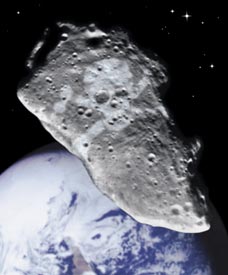
Despite the hype, near-Earth asteroid 2004 MN4 is yet another false alarm.
S&T illustration by Steven Simpson.
Throughout the Christmas holiday weekend, the astronomical community was abuzz over the most significant impact threat to Earth yet found. As late as Monday morning, the near-Earth asteroid 2004 MN4 was given a 1-in-38 chance (2.7 percent) of hitting us 25 years from now — on April 13, 2029, to be exact. But thanks to prediscovery observations, astronomers can now say with total confidence that the asteroid will miss our home planet.
The object was first spotted back in June 2004 but was subsequently lost. It was rediscovered a few weeks ago, giving astronomers a 180-day long orbital arc from which to deduce the asteroid's path. Those calculations put a potential intersection with Earth well within 2004 MN4's orbital error.

The Torino scale combines both the size of the impactor and the probability of impact to determine where on the 10-point risk rating scale a given rock will be judged.
The most common scale used to measure asteroid risk is the "Torino Scale." This 10-point gauge assesses both the impact threat level and the potential damage caused by a given impactor. Due to a history of "Chicken Little-style" news stories about potential asteroid threats that were quickly proven false, Sky & Telescope vowed last year never to report on any events below a Torino rating of 2 (S&T: January 2004, page 8). Since the Torino scale debuted in 1999, no object has risen above a score of one. But over the Christmas weekend, 2004 MN4 rose to level 4 due to the greater than 1 percent chance of impact and the potential for regional (rather than localized) devastation if the body were to strike Earth.
Fortunately, Jeff Larsen and Anne Descour found images of the faint asteroid in images taken on March 15, 2004 at the 0.9-meter Spacewatch Telescope on Kitt Peak, Arizona. With this longer time baseline, astronomers could refine the calculations of 2004 MN4's orbit, which in turn allowed them to determine with certainty that it will miss Earth in 2029.
"An Earth impact on April 13, 2029 can now be ruled out," wrote Don Yeomans, Steve Chesley, and Paul Chodas (NASA/Jet Propulsion Laboratory) in a statement issued Monday afternoon. The asteroid, which has an orbital period of 323 days, might strike Earth sometime in the distant future, but our home planet is safe for a long time to come — at least from this object.
 0
0
Comments
You must be logged in to post a comment.